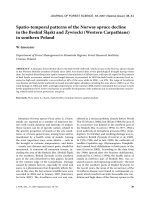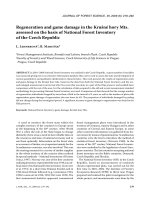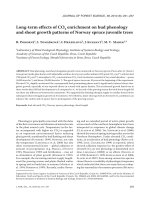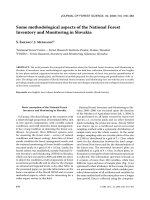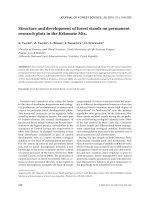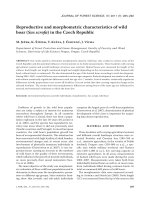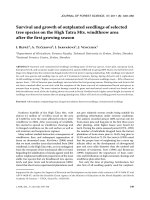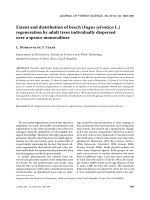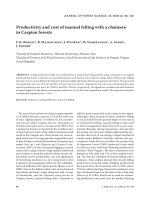Báo cáo lâm nghiệp: "Survival and growth of Acacia mangium Willd. bare-root seedlings after storage and transfer from aeroponic culture to the field" pdf
Bạn đang xem bản rút gọn của tài liệu. Xem và tải ngay bản đầy đủ của tài liệu tại đây (97.6 KB, 3 trang )
475
Ann. For. Sci. 62 (2005) 475–477
© INRA, EDP Sciences, 2005
DOI: 10.1051/forest:2005044
Note
Survival and growth of Acacia mangium Willd. bare-root seedlings
after storage and transfer from aeroponic culture to the field
Jean WEBER
a,b,c
, Yves PRIN
b
,
Foong Yee THAM
a
, Marc DUCOUSSO
b
*, Sing Kong LEE
a
a
Nanyang Technology University/National Institute of Education, Natural Science Division, 1 Nanyang Walk, Singapore 637616, Singapore
b
Laboratoire des Symbioses Tropicales et Méditerranéennes, UMR 113 CIRAD/INRA/Agro-M/UM2/IRD, TA 10/J,
34398 Montpellier Cedex 5, France
c
UMR INRA-University Henri Poincaré Nancy, Interactions Arbres/Microorganismes, Faculté des Sciences, BP 239,
54506 Vandœuvre-lès-Nancy Cedex, France
(Received 30 August 2004; accepted 25 April 2005)
Abstract – Aeroponic culture has been shown to be a promising nursery technique to raise A. mangium and to improve growth rates as well as
the level of controlled infection with rhizobia and mycorrhizal fungi. This work was designed to determine whether aeroponically grown bare-
root seedlings can be stored out of aeroponic troughs, and/or planted to the field without acclimatization in Polybags. After field planting, no
significant differences in terms of survival and growth rates were expressed between bare-root seedlings that had been stored in plastic bags for
six days or directly transferred to the field, or acclimatized in Polybags. Storage in dark conditions for more than four days significantly affected
the survival rates of the seedlings. Aeroponic culture appears to be the method of choice to obtain high quality seedlings, which are much easier
to plant and transport compared to those obtained under classical nursery techniques using soil or solid substrate.
Acacia / aeroponic culture / bare-root / nursery / field planting
Résumé – Survie et croissance de plants en racines nues d’Acacia mangium Willd. après stockage et transfert de culture aéroponique
au champ. La culture aéroponique est une technique de pépinière prometteuse pour la production de plants d’Acacia mangium notamment pour
l’amélioration de la croissance des plants ainsi que pour le contrôle des infections par les rhizobia et les champignons mycorhiziens. Afin de
déterminer si les plants produits en culture aéroponique peuvent être stockés et/ou plantés directement sans période d’acclimatation en Polybags,
un dispositif expérimental a été mis en place. Après plantation au champ, aucune différence significative n’a pu être constatée en termes de
survie et de croissance des plants stockés dans des sachets plastiques pendant 6 jours ou transférés au champ directement ou après une période
d’acclimatation en Polybags. Le stockage à l’obscurité pendant plus de 4 jours réduit significativement la survie des plants. La culture
aéroponique semble être une méthode de choix pour la production de plants de qualité facile à transporter et à planter par rapport aux techniques
classiques de pépinières utilisant un substrat solide ou du sol.
Acacia / culture aéroponique / racines nues / pépinière / plantation au champ
1. INTRODUCTION
Acacia mangium originates from Queensland in Australia,
Papua New Guinea, Irian Jaya, the Sula, Ceram and Aru islands
[6]. It has been introduced in other parts of Southeast Asia
where it is a renowned species for pulpwood plantations due
to its fast growth [2]. The ability of A. mangium to thrive well
on infertile soils has partially been attributed to its symbiotic
association with nitrogen fixing bacteria and mycorrhizal fungi
[5]. Aeroponic culture, a soil-less method, has been shown to
be a promising way for growing and for controlled inoculation
of A. mangium seedlings. Indeed, the growth and the number
of nitrogen-fixing nodules obtained in aeroponic culture has
been shown to be 2 to 4 times higher than those reached on a
solid substratum [8]. Seedlings that had been inoculated with
arbuscular mycorrhizal fungi in pots and raised in aeroponics
have shown significantly higher rates of mycorrhization and
phosphorus content than seedlings grown in soil [7]. Neverthe-
less, little information is available on growing A. mangium in
the field from bare-root seedlings. Bare-root seedlings are
known to be easy and quick to plant as well as convenient to
transport to distant planting sites. Successful trials and pilot
plantings using bare-root A. mangium seedlings have been
reported in the Philippines, these seedlings having also devel-
oped a better root system [10]. However, a direct planting of
aeroponically grown seedlings of A. mangium without any
acclimatization period in Polybags containing solid substrate
has so far not been tested. Due to their fast-growth, lush foliage
* Corresponding author:
Article published by EDP Sciences and available at or />476 J. Weber et al.
and soft roots A. mangium seedlings grown in aeroponic trou-
ghs are particularly sensitive to dehydration. The root system
is also particularly well developed reaching up to 1 m long, lea-
ding to entanglement at the time of transplanting. At the present
time Acacia mangium seedlings are grown on a solid substra-
tum in locally established nurseries because seedling transport
to the field is rather inefficient as a single truck can transport
only a few hundred seedlings at one time. Seedling dispatch to
the field meets the same problems and represents a main part
of the manpower in plantings. Aeroponically-raised bare-root
seedlings can be efficiently packed and easily transported in
boxes that would allow transport in large number over large dis-
tance. The setting up of appropriate transport and storage con-
ditions that do not affect the quality of aeroponically-raised
seedlings are a pivotal matter for the development of industrial
plantations. In this study we compared the effect of direct plan-
ting, pot acclimatization, and storage conditions on the survival
rates and early development of A. mangium seedlings raised in
aeroponic culture.
2. MATERIALS AND METHODS
2.1. Seed germination and the aeroponic system
Seeds of A. mangium (Seedlot No. 19297, Australian Tree Seed
Centre, CSIRO, Australia) were germinated for seven days on moist
tissue paper at room temperature. The seedlings were then carefully
transferred into sponge plugs, previously soaked in water, and grown
for another week in the greenhouse at 30 ± 2 °C. Fourteen-day-old
seedlings were then transferred into an aeroponic trough with their root
system suspended in air [7]. Nutrient mist was supplied to the roots
for 40 s at intervals of 30 s. Plants were maintained in the greenhouse
under tropical environmental conditions with temperatures ranging
from 27 to 32 °C, relative humidity ranging from 80 to 85% and high
illuminance (daylight with a maximum of 800 to 1000 µE·m
–2
·s
–1
).
After 8 weeks, the roots were inoculated with 0.5 mL per plant of a
4-day-old culture of Bradyrhizobium sp. strain AUST13C [3, 4]. The
plants were then grown in the aeroponic troughs for another 5 weeks
before field planting.
2.2. Experimental design
The experiment involved 180 plants in 6 treatments using 30 plants
for each treatment. Plants were randomly assigned to each treatment
from a population of 400 aeroponically-grown seedlings. Four of the
treatments concerned storage conditions. For these plants, before stor-
age the plants were cut to the height of the last remaining bud at
between 20 and 30 cm on the stem. The roots were cut to a length of
25 cm. The plants were packed in 20 L transparent plastic bags at a
rate of 5 plants per bag, which were inflated with air and sealed. The
bags were stored in darkness for 4 and 6 days (4DD, 6DD) or in the
shade for 4 and 6 days (4DS, 6DS). The two other treatments consisted
of direct planting of seedlings from the aeroponic trough (NSt) and
acclimatization of seedlings in 1.5 L Polybags for 2 weeks before
planting (PA). For these treatments, the stalk and the roots were
reduced as described above and the Polybags were filled with soil from
the planting site. The plants were watered daily with the same nutrient
solution as used in aeroponic culture. The roots were cut just before
the transfer to the Polybags and the stalks just before the transfer to
the field. Within 2 days plants of all treatments were labeled and trans-
planted into a fully randomized design in the field in 6 rows of 30 plants
each with a square spacing of 1 m. The planting site was on reclaimed
land, having a moderately deep clay layer and poor drainage. Plant
growth rates were calculated from the height measured between the
collar and the last living bud before transplanting and at 2 and 7 months
after planting out.
2.3. Statistical analysis
A single factor analysis of variance (ANOVA) was performed to
determine significant difference of plant height and growth between
treatments at P < 0.05. Differences of survival among the different
treatments were estimated by the [Khi]
2
test at P < 0.05. These test
procedures were carried out with MINITAB software [9].
3. RESULTS
3.1. Transplanting stress and survival after planting
Transplanting stress was visible after one week. Some plants
began to loose leaves and, under sunlight, the grass-green color
of the stem turned to a more brownish color. In some cases, the
terminal bud died and growth began in the underlying bud. An
examination of the transplants revealed that 2 weeks after trans-
planting, new lateral roots had developed. Two months after
transplanting, all the seedlings were growing well without visi-
ble symptoms of stress. The healthy appearance of the plants
2 months after transplanting showed that the seedlings were
able to overcome the initial transplanting stress. The distribu-
tion of surviving plants was uniform over the different treat-
ments (P < 0.05). Treatment 6DD significantly affected the
survival of the transplanted seedlings (73% against 93–96%).
No significant difference in mortality was observed for the
other treatments (4–7%).
3.2. Plant growth after transplanting
During the first 2 months, growth rates were moderate com-
paring to those observed for the following 5 months (Fig. 1).
Plants of the treatment 6DD were sensitive to transplanting
stress as their growth rates were significantly lower than those
of the other treatments except for the treatment 4DD. Storage
in dark conditions increased the sensitivity to transplanting
stress even after only 4 days. Between the 2nd and the 7th
months after transplanting, no significant differences in growth
rates have been measured between the treatments.
4. DISCUSSION
In plantations, survival rates are linked to the ability to sur-
vive transplanting stress and to out-compete the growth of
noxious grasses. Storage in dark conditions slowed down the
recovery of growth and increased mortality after planting, thus
affecting the plantation success. The comparatively moderate
growth rates observed for each treatment after 2 months were
probably linked to the fact that the growth recovery was not ini-
tiated from the top shoot but from lateral buds that formed a
new leader. The growth of topped seedlings has been reported
to recover in a short period without adverse effects or subse-
quent plant deformations [1, 6]. Fast-growing A. mangium,
which develop a soft stalk and lush foliage were reported to be
Planting aeroponic Acacia mangium seedlings 477
fragile for handling and sensitive to desiccation. However, it
has been shown that they establish well and with a good sub-
sequent growth [6]. This observation was confirmed by our
results with A. mangium grown in aeroponic culture. The per-
centage survival rates after transplanting were comparable with
the 97% obtained with the use of containerized seedlings raised
under traditional nursery techniques [6]. For fast-growing see-
dlings a 3 to 4 week hardening procedure has been seen as
essential before their transplanting to the field. This procedure
consists usually of exposure to full sunlight, and a progressive
reduction of nitrogen fertilization and watering with a view to
encourage woodiness [6]. The use of bare-root seedlings con-
ditioned in blown-up plastic bags allows the protection of
saplings from dehydration and transportation shocks. Field
trials in the context of industrial plantings are under progress
in collaboration with an industrial pulp company.
Acknowledgements: This work was co-funded by the National Insti-
tute of Education of Singapore and the French Ministry of Foreign
Affairs. Thanks are also expressed to Olivier Crassard and Patrick
Durand respectively for their scientific and administrative assistance.
REFERENCES
[1] Adjers G., Luukkanen O., Field comparison of A. mangium see-
dlings with damaged and intact top shoots, in: Ministry of Forestry
of Indonesia (Ed.), Trials established in 1986–1987 in the Mecha-
nized Nursery and Plantation Project in South Kalimantan (ATA-
267), Jakarta, Enso Gutzeit Ltd, FINNIDA and University of Hel-
sinki, Finland, 1988.
[2] Cossalter C., Pye-Smith C., Fast-wood Forestry. Myth and realities.
Center for International Forestry Research, Jakarta, Indonesia,
2003.
[3] Diouf D., Forestier S., Neyra M., Lesueur D., Optimisation of ino-
culation of Leucaena leucocephala and Acacia mangium with
rhizobium under greenhouse conditions, Ann. For. Sci. 60 (2003)
379–384.
[4] Galiana A., Chaumont J., Diem H.G., Dommergues Y.R., Nitro-
gen-fixing potential of Acacia mangium and Acacia auriculiformis
seedlings inoculated with Bradyrhizobium and Rhizobium spp.,
Biol. Fertil. Soils 9 (1990) 261–267.
[5] Galiana A., N’Guessan Kanga A., Gnahoua G.M., Balle P., Dupuy
B., Domenach A.M., Mallet B., Fixation de l’azote chez Acacia
mangium en plantation, Bois For. Trop. 249 (1996) 51–62.
[6] Kamis A., Taylor D., Acacia mangium growing and utilization,
MPTS Monograph Series No. 3, Bangkok, Thailand, Winrock
International and FAO, 1993.
[7] Martin-Laurent F., Fremont M., Lee S.K., Tham F.Y., Prin Y., Tan
T.K., Diem H.G., Effect of inoculation with selected Bradyrhizo-
bium spp. on the survival and growth of Acacia mangium saplings
after 20 months in the field, J. Trop. For. Sci. 11 (1999) 470–483.
[8] Martin-Laurent F., Lee S K., Tham F Y., He J., Diem H.G., Durand
P., A new approach to enhance growth and nodulation of Acacia
mangium through aeroponic culture, Biol. Fertil. Soil. 5 (1997) 7–12.
[9] Ryan B.F., Joiner B.L., Ryan, T.A., Minitab handbook, Duxburry
press, Boston, 1985.
[10] Schroeder P.F., Nursery procedure manual, ASEAN-New Zealand
Afforestation project, Manila, Philippines, 1987.
Figure 1. Acacia mangium shoot growth in cm (means and standard deviations) 2 months after transplanting and between 2 and 7 months after
transplanting according to applied storage conditions. Values under the same bar are not significantly different at P < 0.05, for both durations.

